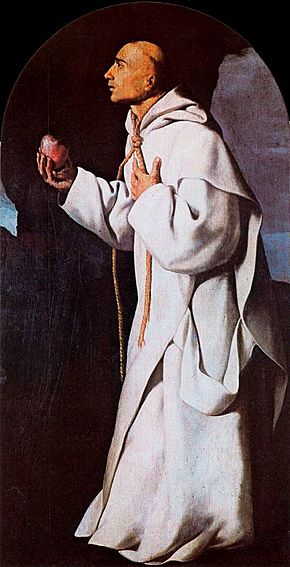John Houghton (martyr) facts for kids
Quick facts for kids SaintJohn Houghton OCart |
|
|---|---|

Blessed John Houghton, by Francisco Zurbarán
|
|
| Martyr | |
| Born | c. 1487 Essex, England |
| Died | 4 May 1535 (aged 47–48) Tyburn, London, England |
| Venerated in | Roman Catholic Church |
| Beatified | 29 December 1886 by Pope Leo XIII |
| Canonized | 25 October 1970 by Pope Paul VI |
| Feast | 4 May, 25 October |
| Attributes | Carthusian habit, noose in neck, heart in hand, knife, book, martyr's palm |
John Houghton (born around 1487 – died May 4, 1535) was a brave Catholic priest from the Carthusian order. He was the first person to die as a martyr because of King Henry VIII of England's new laws. These laws changed who was in charge of the church in England.
John Houghton was also the first Carthusian monk to become a martyr. He is remembered as one of the Carthusian Martyrs of London and is part of a group called the Forty Martyrs of England and Wales.
Contents
Early Life of John Houghton
John Houghton was born in England around 1487. Some say he went to Cambridge University for his education. However, old records don't clearly show his time there. We also don't have clear records of when he became a priest.
It is said that after finishing his studies, he wanted to become a monk. He avoided an arranged marriage to follow his religious calling.
Monastic Life and Challenges
In 1516, John Houghton joined the London Charterhouse, which was a Carthusian monastery. He took on different roles there. In 1523, he became the sacristan, which meant he was in charge of the church's sacred items. Then, in 1528, he became the procurator, managing the monastery's money and supplies.
In 1531, he became the prior (leader) of the Beauvale Priory in Nottinghamshire. But later that year, he was chosen to be the prior of the London Charterhouse again. The next spring, he was also named the main leader for all Carthusian monasteries in England.
Conflict with King Henry VIII
In April 1534, King Henry VIII sent people to the Charterhouse. The King was making big changes to the church in England. He wanted to divorce his wife and marry again. He also wanted to be the head of the church, not the Pope.
John Houghton told the King's agents that it wasn't his job, or his monks' job, to get involved in the King's personal matters. He said it didn't concern him who the King married or divorced. He asked if he and his monks could be excused from a new oath. This oath was part of the First Succession Act, which recognized the King's new marriage and his children as legal heirs.
Because of this, John Houghton and another monk, Humphrey Middlemore, were arrested. They were taken to the Tower of London. However, by the end of May, they were convinced that the oath was okay for their faith. It had a special phrase: "as far as the law of Christ allows." So, they returned to the Charterhouse. With many armed guards watching, all the monks took the oath.
Arrest and Execution
In 1535, things changed again. The King introduced a new law called the Act of Supremacy. This law said that King Henry VIII was the "Supreme Head of the Church of England." This meant the King, not the Pope, was in charge of the church.
John Houghton, along with the leaders of two other Carthusian monasteries, Robert Lawrence and Augustine Webster, asked for an exception from this new oath. But this time, they were arrested right away.
In April 1535, they were brought before a special court. They were sentenced to death. Another monk, Richard Reynolds, and a priest named John Haile were also sentenced with them.
Martyrdom at Tyburn
On May 4, 1535, John Houghton, the other two Carthusian leaders, Reynolds, and Haile were taken to Tyburn to be executed. They were still wearing their monk's clothes.
From his prison cell in the Tower of London, Thomas More, another famous martyr, saw them. He told his daughter, "Look, Meg! These blessed Fathers be now as cheerfully going to their deaths as bridegrooms to their marriage!" This shows how brave and calm they were.
John Houghton was the first to be executed. He was put to death in a very harsh way. It is said that as the executioner began to harm him, John Houghton prayed, "O Jesus, what wouldst thou do with my heart?" His companions were also executed. After his death, his body was cut into pieces and displayed in different parts of London.
Legacy of Saint John Houghton
John Houghton was honored by the Catholic Church many years later. He was declared "blessed" on December 29, 1886, by Pope Leo XIII. Then, on October 25, 1970, Pope Paul VI declared him a "saint."
There are many places where Saint John Houghton is remembered:
- A beautiful mosaic of him is in the Holy Name of Jesus Roman Catholic Church in Chorlton-on-Medlock, Manchester.
- A famous painting by Francisco Zurbarán shows him holding his heart and with a rope around his neck.
- In the Chapter house of St. Hugh's Charterhouse in England, there is a painting that shows the execution of the three Carthusian leaders.
You can also find stained glass windows of Saint John Houghton in these churches:
- St Dominic's Priory Church in London
- Our Lady and the English Martyrs Church in Cambridge
- Belmont Abbey, Herefordshire near Hereford
- St. Mark's Church, Mansfield in Mansfield
- Shrewsbury Cathedral, where he is next to Thomas More in one of the windows.
A school, St John Houghton Catholic Voluntary Academy, is named in his honor.

